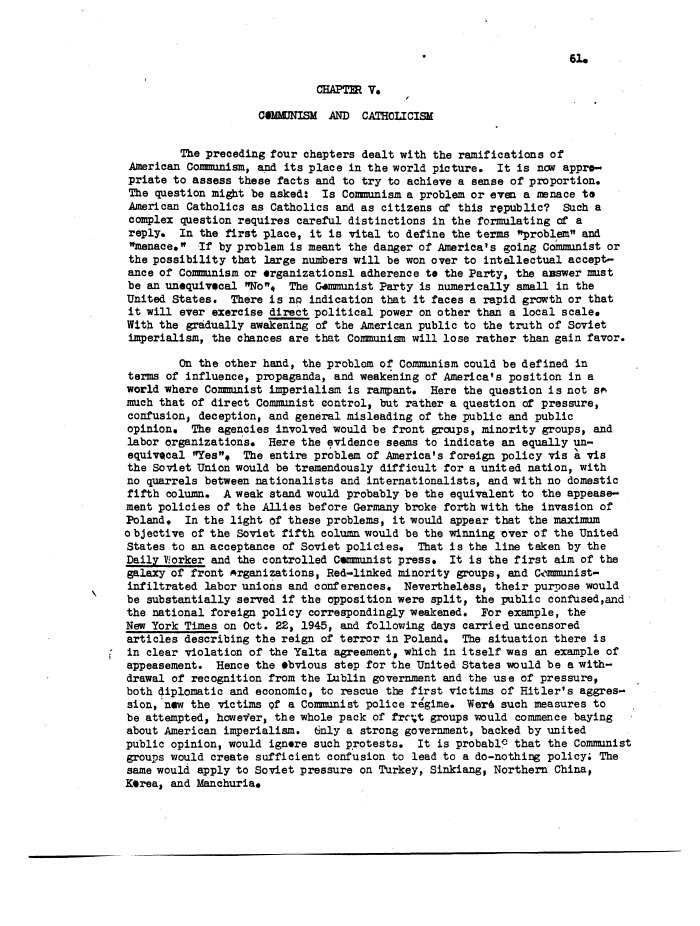 |
||||
 |
||||
| 61, CHAPTER 7» / CfMMDNISM AND CATHOLICISM The preceding four chapters dealt with the ramifications of American Communism, and its place in the world picture. It is now appro-* priate to assess these facts and to try to achieve a sense of proportion* The question migjit be asked: Is Communism a problem or even a menace ta American Catholics as Catholics and as citizens of this republic? Such a complex question requires careful distinctions in the formulating of a reply. In the first place, it is vital to define the terms "problem" and "menace." If by problem is meant the danger of America's going Communist or the possibility that large numbers will be won over to intellectual accept- ance of Communism or organizations! adherence to the Party, the asswer must be an unequivocal "No"* The Communist Party is numerically small in the United States. There is np indication that it faces a rapid growth or that it will ever exercise direct political power on other than a local scale. With the gradually awakening of the American public to the truth of Soviet imperialism, the chances are that Communism will lose rather than gain favor. On the other hand, the problem of Communism could be defined in terms of influence, propaganda, and weakening of America's position in a world where Communist imperialism is rampant. Here the question is not sr much that of direct Communist control, but rather a question of pressure, confusion, deception, and general misleading of the public and public opinion* The agencies involved would be front groups, minority groups, and labor organizations* Here the evidence seems to indicate an equally un~ equivocal Tes"* The entire problem of America's foreign policy vis a vis the Soviet Union would be tremendously difficult for a united nation, with no quarrels between nationalists and internationalists, and with no domestic fifth column. A weak stand would probably be the equivalent to the appease- ment policies of the Allies before Germany broke forth with the invasion of Poland* In the light of these problems, it would appear that the maximum objective of the Soviet fifth column would be the winning over of the United States to an acceptance of Soviet policies* That is the line taken by the Daily Worker and the controlled Communist press* It is the first aim of the galaxy of front organizations, Red-linked minority groups, and Cx.'ramunist- infiltrated labor unions and conferences. Nevertheless, their purpose would be substantially served if the opposition were split, the public confused,and the national foreign policy correspondingly weakened. For example, the New York Times on Oct. 22, 1945, and following days carried uncensored articles describing the reign of terror in Poland. The situation there is in clear violation of the Yalta agreement, which in itself was an example of appeasement. Hence the obvious step for the United States would be a with- drawal of recognition from the Lublin government and the use of pressure, both diplomatic and economic, to rescue the first victims of Hitler's aggres- sion, now the victims of a Communist police regime. Were such measures to be attempted, however, the whole pack of frr^t groups would commence baying about American imperialism. 6nly a strong government, backed by united public opinion, would ignore such protests. It is probable that the Communist groups would create sufficient confusion to lead to a do-nothing policy; The same would apply to Soviet pressure on Turkey, Sinkiang, Northern China, Korea, and Manchuria* |